ISOMAX Training—Surefire Methods to Explode Your Strength and Muscle
Those athletes and coaches unfamiliar with the discipline of isometric strength training might take a look at an ISOMAX and respond—looks cool, but what do I DO with it?
You’d be amazed what you can achieve with this tool.
The Dragon Door Research Team has compiled an in-depth, hugely researched and annotated 400+ page manual to answer that question to the full. In the meantime, this article will give you the Cliff’s.
ISOMAX DRILLS:
In essence, the ISOMAX gives an athlete a line of vertical resistance. In that sense, it’s a lot like handling a barbell as a training tool—with the exceptions that an ISOMAX is less cumbersome, doesn’t require as much space, doesn’t require plate changes, is digitally accurate in terms of force measurement, and so on.
Think of dynamic exercises you can perform standing with a barbell. This roll-call will consist of the greatest techniques in the world for strength and muscle gain: squats, deadlifts, rows, presses, curls—if you are a lifter, you can probably think of at least a dozen more. Every single one these exercises can be performed as isometric drills with the ISOMAX—with up to a thousand pounds resistance.
Here’s an itinerary of the ten most basic isometric drills:
The ISO-TEN Techniques:
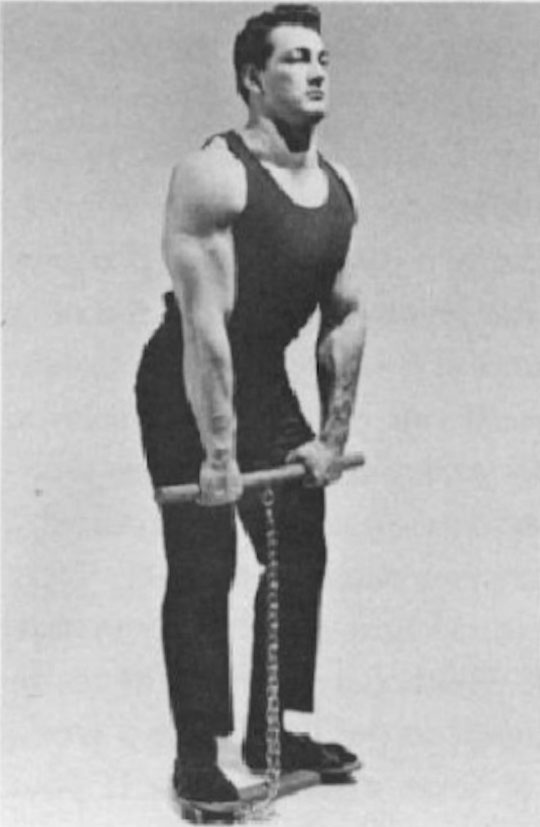 1. DEADLIFTS
1. DEADLIFTS
Classic primal strength builder for the entire posterior chain. Can be performed at any point of motion: also in hack or straddle lift-styles.
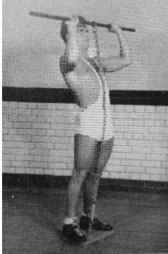 2. MILITARY PRESS
2. MILITARY PRESS
Traditional upper-body exercise for the entire shoulder girdle and triceps. Can be performed anywhere from chest to lockout.
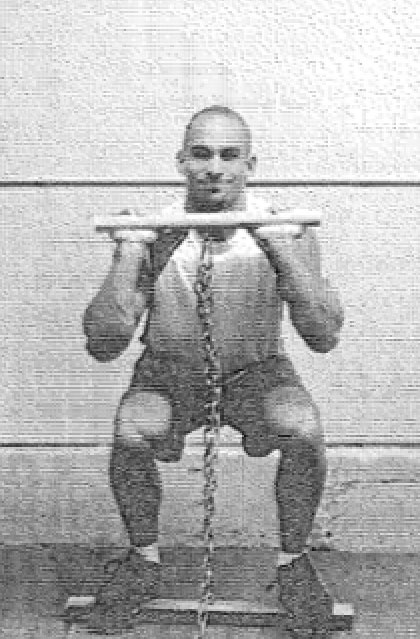 3. FRONT SQUAT
3. FRONT SQUAT
Fundamental technique for the entire lower body, spine and hips; also promotes balance. Can be performed at any point of motion.
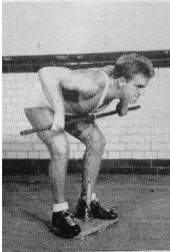 4. BENT-OVER ROW
4. BENT-OVER ROW
Ultimate upper-back builder, with the added benefit of being a peak contraction hold. Underhand or overhand grip.
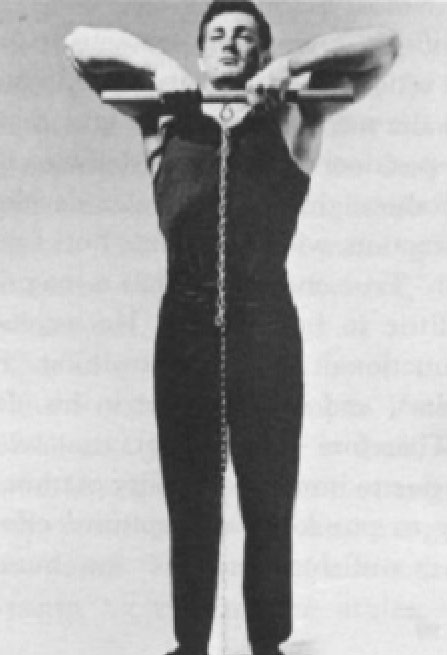 5. HIGH PULL
5. HIGH PULL
Old school deltoid developer. Can be performed in low, Olympic-style, or higher, as an upright row (shown).
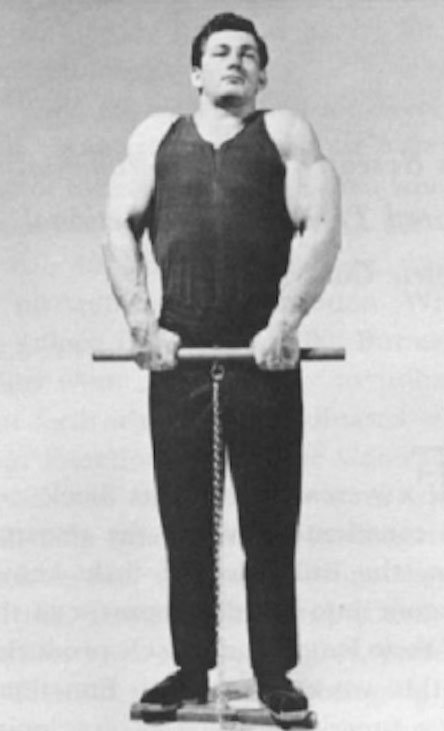 6. SHRUG
6. SHRUG
Number-one movement for the traps, upper-back and neck. Also gives a great workout to the grip plus the spinal muscles.
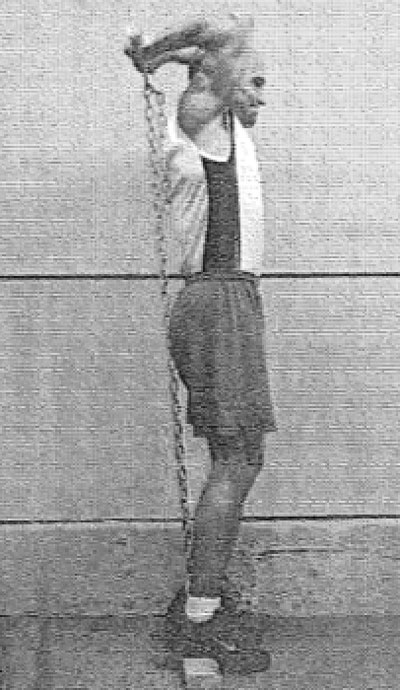 7. TRICEPS EXTENSION
7. TRICEPS EXTENSION
A.k.a. the "French press", the original move for building the triceps/strengthening the elbows. Overhand or underhand grip.
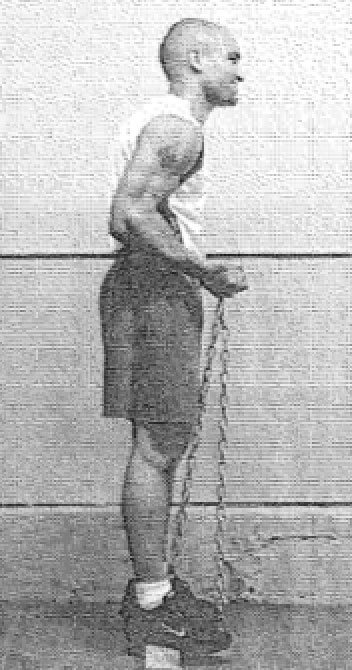 8. CURL
8. CURL
The ultimate biceps exercise: provides 100% maximal tension—unlike barbell curls. Can be done regular or reverse-style.
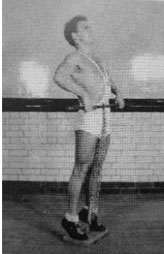 9. CALF RAISE
9. CALF RAISE
Basic exercise for the calves, ankles and feet. Can be performed Olympic-style (shown) or in front squat/ deadlift positions.
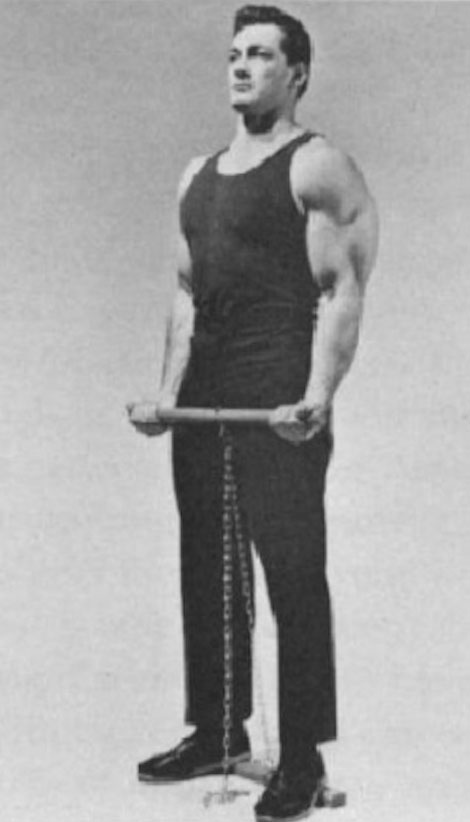 10. GRIP HOLD
10. GRIP HOLD
Archetypal grip and forearm builder. Can be performed overhand as a finger curl or hold, or underhand, in wrist curl style (shown).
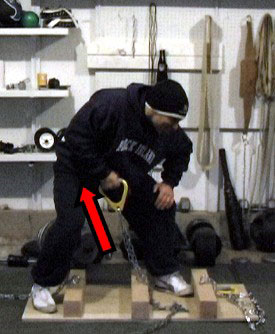 (A million thanks to Ross Enamait—a long-term champion of isometrics—for his permission to use his training images. Go to www.rosstraining.com.)
(A million thanks to Ross Enamait—a long-term champion of isometrics—for his permission to use his training images. Go to www.rosstraining.com.)
ADVANCED ISOMAX DRILLS:
These ten—great as they may be—are far from the end of the story when it comes to ISOMAX training—they are only the beginning. As you advance with the device, there is much more to explore:
A. Multi-angular training.
Because the length of the ISOMAX can be quickly altered if you wish—in two-inch increments—you can work multiple angles of any drill, for a bigger bang for your buck. This means a basic curl becomes three curls; four; five, and so on.
Alternately, you can select a highly specific angle to work a particular stubborn muscle-area, or to help you power through a sticking point of a dynamic exercise (a favorite isometric method of weightlifters and powerlifters).
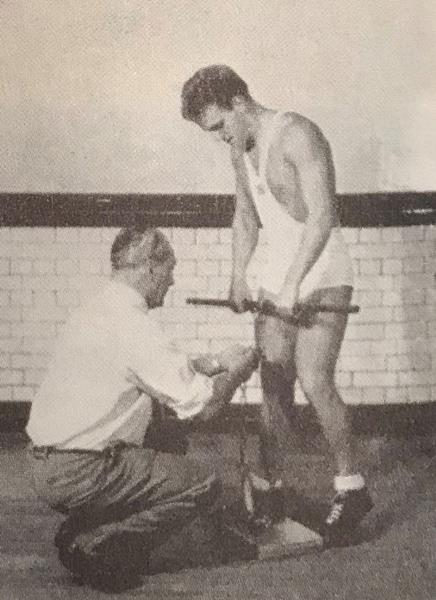 Legendary Olympic weightlifting coach Al Murray adjusts the chain on the device his athlete is using (1963).
Legendary Olympic weightlifting coach Al Murray adjusts the chain on the device his athlete is using (1963).
B. Behind-the-back holds.
ISOMAX drills don’t have to be performed with the handle in front of the athlete. The addition of an audio device in the handle—which tells users when they have reached their target force level—means that behind-the-back exercises can be performed with full feedback. If you chose, the ISOMAX will also time you for the perfect repetition.
This means great old school strength and mass builders like hack lifts, rear shrugs, sissy squat holds, rear triceps lockouts, behind-the-back wrist curl holds and finger holds, and so on, are back on the menu for serious athletes.
C. Seated Training.
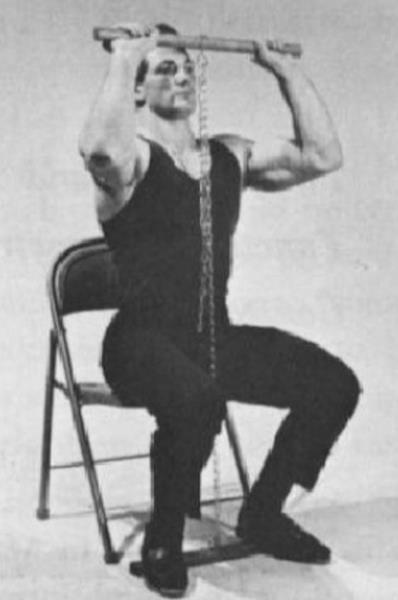 Seated strength training is a mainstay in gyms, and has been for generations. It’s elementary to use the ISOMAX while seated to provide a new stimulus, to encourage isolation and perfect form, or for an ideal workaround when you’ve got a back or leg injury. Get in a terrific training session with seated curls and presses at different angles, reverse curls, spider curls, front raises, triceps presses, wrist curls, and so on.
Seated strength training is a mainstay in gyms, and has been for generations. It’s elementary to use the ISOMAX while seated to provide a new stimulus, to encourage isolation and perfect form, or for an ideal workaround when you’ve got a back or leg injury. Get in a terrific training session with seated curls and presses at different angles, reverse curls, spider curls, front raises, triceps presses, wrist curls, and so on.
D. Omni-directional options.
As well as the basic vertical standing or seated drills, the ISOMAX can also be used in different directions; for example, you can sit on the floor and press against the footplate in various seated row or pull combinations.
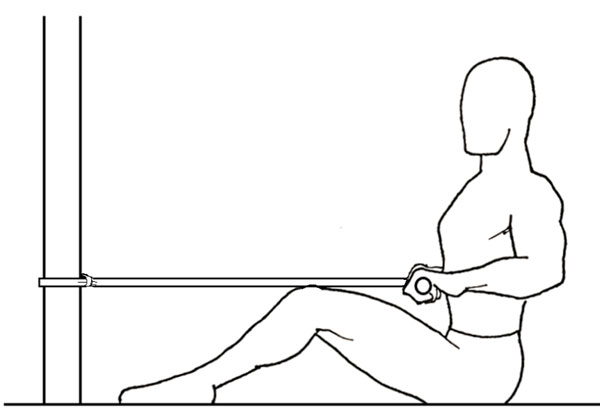 Because the chain and handle can be rapidly disconnected from the footplate via a carabiner (snap-hook), you can also use the device without the baseplate if you wish. For example, you can attach it to a vertical column or pole to perform pulls from different angles; or you can connect it to a rafter or overhead point, to perform isometric pulldowns, triceps pushdowns or press combinations. Virtually every free weight or cable exercise can be performed isometrically with the ISOMAX.
Because the chain and handle can be rapidly disconnected from the footplate via a carabiner (snap-hook), you can also use the device without the baseplate if you wish. For example, you can attach it to a vertical column or pole to perform pulls from different angles; or you can connect it to a rafter or overhead point, to perform isometric pulldowns, triceps pushdowns or press combinations. Virtually every free weight or cable exercise can be performed isometrically with the ISOMAX.
PROGRAMMING ISOMETRICS
For athletes and coaches mentally conditioned to conventional forms of training (lift this up, put it down, repeat) programming isometrics may seem daunting at first. In fact, once you get used to it, isometric programming is elegant, simple and satisfying, and as soon as you’ve grasped the basic principles you can easily generate your own workout templates based on your particular goals.
For more on the science behind isometric training, go here.
In the meantime, here are some fast answers to some fundamental questions:
Can I cross-train with the ISOMAX?
Yes. Isometrics are the least exhausting method of strength training; despite maximum loads being used, recovery is unbelievably rapid compared to other systems. This means you can get the benefits of isometric training even you are performing alternative, more demanding sports or disciplines: martial arts, powerlifting, kettlebell work, etc.
How often can I train in isometrics?
Because athletes have been proven to recover faster from isometrics than all other methods of resistance training, maximal isometric workouts can be performed daily if you wish. You don’t need to train isos daily to get the benefits, however. Three sessions per week is a great guideline.
How long are isometric training sessions?
Consensus among sports scientists is that optimal isometric training sessions should be between ten and fifteen minutes long.
To those used to conventional training, this may not sound adequate: but remember that isometrics is, mathematically, the most productive form of training possible—there are no pauses between reps, and no "easy" portion of a rep, so isometric holds confer more productive effort, faster than dynamic sets. Whereas a dynamic set may take 40 seconds, the same workload can be achieved in six seconds in an isometric hold.
The ISOMAX Training Manual also contains chapters on perfect warm-ups and cool-downs for iso sessions.
How long are isometric holds?
Extensive research data indicates that the ideal isometric repetition for rapid strength development is six seconds, at maximum voluntary effort. Athletes cannot immediately summon maximum tension in the muscles, so each rep should include a few seconds "rise time" to smoothly build up to peak force—each optimal isometric hold will take around ten seconds or so, total.
You don’t need to look at a clock to achieve this perfect isometric repetition. The ISOMAX contains a built-in Timed Mode which audibly tells you when you have reached your target force level, and which rises in pitch each second, finishing with a longer tone to tell you that the hold is completed.
That said, if you want to focus on muscular endurance, the ISOMAX has a built-in Load Mode which allows you to customize your hold times to longer periods; thirty seconds, a minute, five minutes, etc.
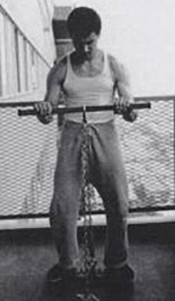 Bruce Lee was passionate about isometrics. Here he works his famous forearms with the reverse curl hold.
Bruce Lee was passionate about isometrics. Here he works his famous forearms with the reverse curl hold.
For more on the ISOMAX Training Modes, click here.
I’m used to "sets-and-reps" style training. Do I need to perform holds?
If you don’t want to perform "strict" isometrics on the ISOMAX, you don’t have to. You can simply enter your target force level on the console, and begin performing "reps"—lift the bar until the console tells you you’ve reached (or exceeded) the weight you’ve entered, then relax before performing another rep. Wash rinse and repeat: just like regular "sets-and-reps". Try to hold the target weight in position for at least one second to gain maximum benefit, however.
The high-strength steel tension spring which attaches the footplate to the chain has just enough "give" to mimic a live load, and makes this approach surprisingly satisfying, demanding, and productive. This can be a nice change of pace, and works well for deadlifts, presses, curls and numerous other traditional exercises.
How many holds do I need to perform for each drill?
The science says that the total time of the working hold is the key to optimal strength progress. The ideal total sum is about 36-40 seconds. Therefore, if you are performing the recommended "perfect" six-second reps, you should be doing six reps per drill, per training session.
If you are performing "sets-and-reps" and your holds are only about one second each, you should be performing around 40 total reps per drill, per session. (4 sets of ten, 5 sets of 8, etc.)
How do I make progress?
Progress with isometrics could not be simpler or more logical. The ISOMAX Training Modes allow you to enter a target force level (as weight: your choice of either pounds of kilos). When you can hold that level for six seconds (registered by the display), jack the weight up by 10lbs or 5 kilos, and repeat. Of course, you can use longer holds—30 seconds, a minute, and so on—as goals if you want.
Isometrics is proven to be the fastest method for increasing absolute strength.
How quickly will my gains slow down with isometrics?
It’s true that all forms of strength training—in fact, all forms of learning—proceed under the Law of Diminishing Returns. The longer you train, the harder it is to get results. There also seems to be a second law in operation: that the faster a particular method gives you results, the more dramatically the Law of Diminishing returns applies.
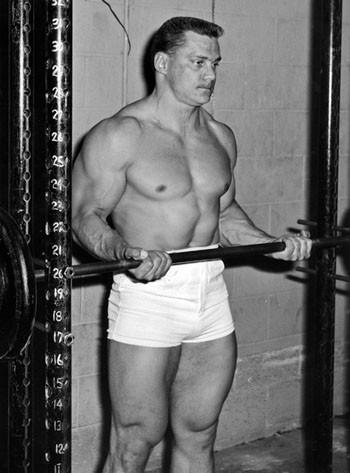
Bill March built his incredible strength in the isometric power rack. It didn’t hurt his physique, either.
This needn’t be the case with isometrics (or any other form of training), however. The World Champion weightlifter Bill March was one of the earliest test subjects for isometrics, and used the system to become a gold medalist in record time. When he was asked when he thought his progress would "run out" he replied:
"If you are wondering about hitting a limit poundage—don’t. I do not believe there is one!"
March and his coaches understood that the way to avoid hitting plateaus is to alter your training stimulus. Change your exercises; your hold times; your intensity; your volume; your training angle; order of drills; etc. Although the Law of Diminishing Returns still applies—there is no way to completely avoid it—if you alter your training variables like this every 6-8 weeks, you can continue getting bigger and stronger almost indefinitely.
The ISOMAX Training Manual contains scores of potential programs to help keep you out permanently of a training rut, including bleeding-edge scientifically-designed sessions as well as classic workouts by the trailblazers who first championed isometrics, including:
- Bruce Lee’s isometric workout for serious martial artists;
- Combining isometrics and kettlebell training;
- Louie Simmons approach to isos for powerlifting;
- Bob Hoffman’s influential "Big 8" workout;
- Sisco and Little’s Static Contraction Method for advanced bodybuilders;
- Alistair Murray’s program for Olympic weightlifters;
- A look at Chad Waterbury’s isos for hypertrophy;
- Complete bodyweight isometrics (by Paul "Coach" Wade);
Plus many bonus features.
Are you convinced yet? Click here to order.
Need more information on the science behind isometrics? Click here.
Need more specs on the ISOMAX? Click here.
JOIN THE ISOMETRIC REVOLUTION
In the late nineties Dragon Door revolutionized the strength and conditioning world when we re-introduced kettlebells to Europe and America.
In 2001 Dragon Door revolutionized nutrition when we published Ori Hofmekler’s The Warrior Diet—the first ever book on intermittent fasting.
In 2010 Dragon Door revolutionized the training world again when we revived functional bodyweight strength training worldwide, via the best-selling Convict Conditioning and the Kavadlo Brothers’ books and certs.
Those "in the know" in the fitness world watch Dragon Door very carefully—because this is the House Where Revolutions Begin. And it’s about to happen again. We invite you to join us now!
Barbells and dumbbells represent Stone Age technology.
-Mike Mentzer